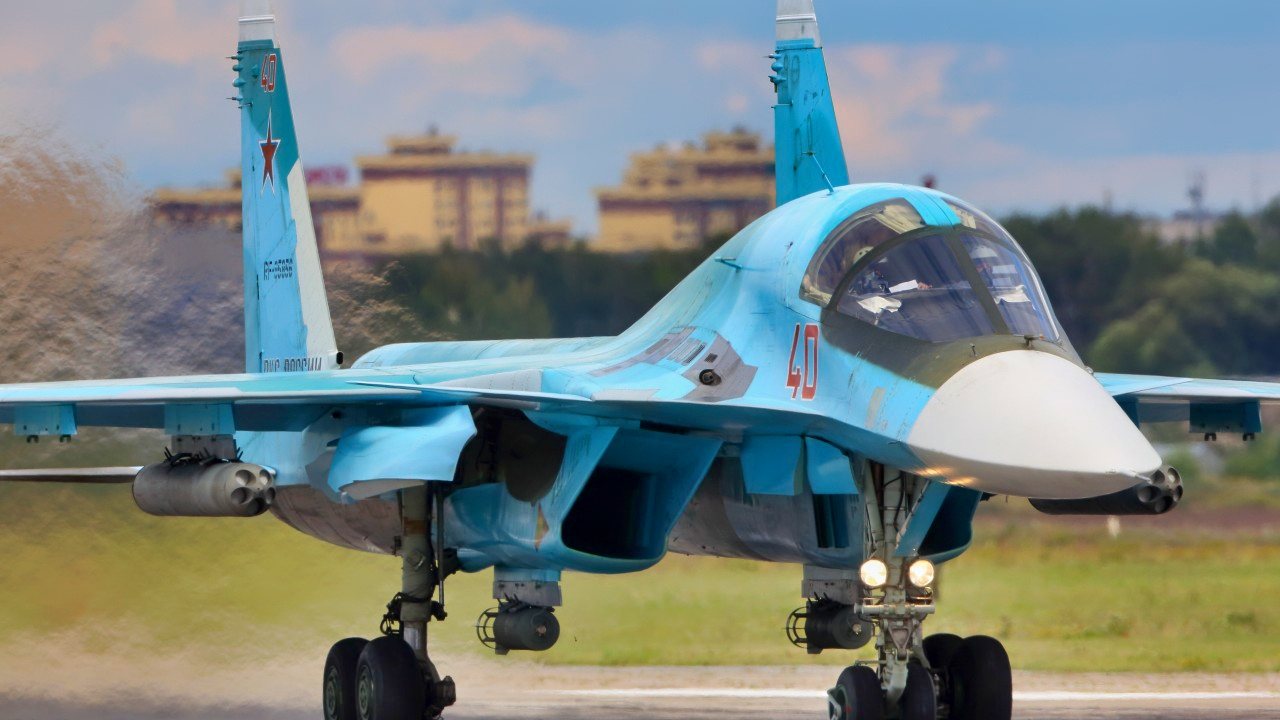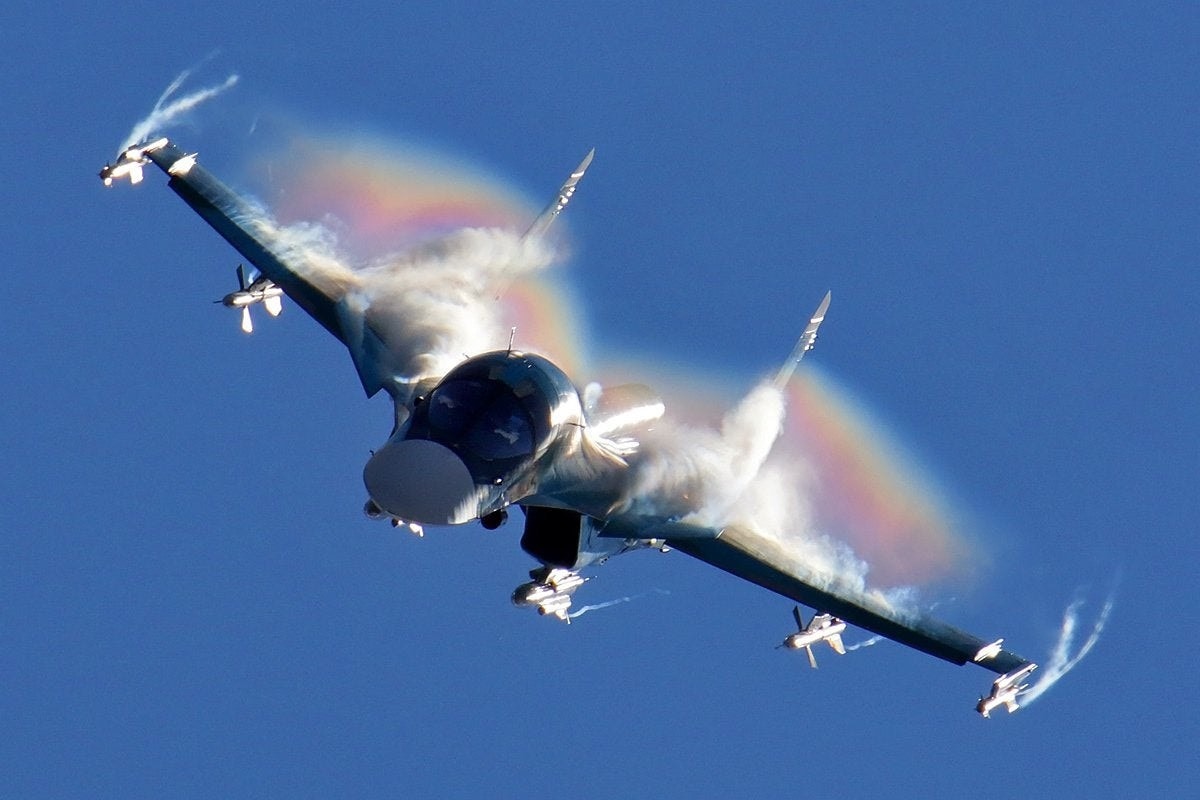Russia's Su-34 Lesson in Ukraine Is One That Can't Be Ignored
Despite the losses the Su-34 has sustained in the conflict, the warbird continues to be “good enough” for achieving Russia’s overarching strategic objectives.
The Su-34, codenamed “Fullback” by NATO, is a twin-seat, twin-engine, all-weather supersonic fighter bomber that stands as a testament to the Russian military’s engineering prowess. Developed by the Sukhoi Design Bureau, the Su-34 was designed to replace the aging Soviet era Su-24 tactical bomber.

What’s more, the Su-34 was meant to fulfill various combat mission sets. The Fullback’s maiden flight occurred in 1990, when the Soviet Union was in its painful final year of collapse and the Cold War was coming to an end (meaning that the enemy that the Su-34 was designed to fight was no more).
Fullback was stuck in “development Hell” for much of the 1990s, due to the absolute chaos pit that post-Soviet Russia had become. It did not enter service with the Russian Air Force until the early 2010s.
And while quite a few Su-34s have been famously taken down in Ukraine, the Fullback is not a warplane to ignore.
The Su-34 Specs
Derived from the Su-27 Flanker, the Su-34 inherited the Flankers maneuverability and speed. The Fullback can fight in any weather condition. It is not only an air superiority fighter, but it serves as a bomber and in strike operations. The Flanker’s primary strength, though, is in its tactical bombing capability.

Equipped with an armored cockpit and electronic warfare capability, the Su-34 carries a wide array of munitions, such as air-to-air, air-to-surface, and anti-ship missiles. A 30mm cannon and conventional bombs round out this heavy bird’s offensive capabilities. This is a highly versatile plane that can engage a variety targets.
The Fullback can cruise at about Mach 2 (or 1,500 miles per hour). Its operational range is about 2,500 (without aerial refueling). A Su-34 can withstand up to 9G forces. Its designers intended for the Fullback to be a dominant player in high-intensity combat.
There are two primary variants of this bird, both of which Russia exports to other nations. There’s the Su-34 and the maritime strike version, the Su-34FN. The maritime strike fighter possesses a Sea Snake radar, anti-submarine warfare systems, radio sonobuoy system, and a magnetic anomaly detector. This variant is designed to enhance the aircraft’s capabilities in naval warfare, making it a highly sought after system globally.
Some Unique Challenges
Nevertheless, the Fullback has faced unique challenges in the unfriendly skies over Ukraine. The Armed Forces of Ukraine defending against Russia’s invasion have destroyed multiple Su-34s in the air and even on the ground. In fact, the Su-34’s performance in Ukraine has left much to be desired in the minds of Russian war planners.
It continues to be used because it is cheap to mass produce and still somewhat effective. Russia is at a point in its war where it seeks to utilize every available asset to achieve victory.
Just as with the Su-35 and basically every other weapons platform the Russians are using in the Ukraine War, Moscow doesn’t need these systems to be pretty or perfect. That’s an American obsession when it comes to weapons systems. Moscow just needs these systems to be effective at pushing the ultimate strategic goal—defeating the Ukrainian military as a means of defeating the Ukrainian state’s threat to Russian holdings in Eastern Ukraine and Crimea.

Despite the losses the Su-34 has sustained in the conflict, the warbird continues to be “good enough” for achieving Russia’s overarching strategic objectives.
The West is Losing to Russia
Thus, the West is about to lose to a military that has deployed subpar systems, like the Su-34. But the Russians have utilized those subpar systems with far greater effect than have Western forces with their sophisticated, fancy, whizbang technology.
One hopes that it isn’t a portent of things to come, as the geopolitical situation turns against the United States everywhere.
Sadly, one cannot help but to think that is precisely what this is.
About the Author
Brandon J. Weichert, a National Interest national security analyst, is a former Congressional staffer and geopolitical analyst who is a contributor at The Washington Times, the Asia Times, and The-Pipeline. He is the author of Winning Space: How America Remains a Superpower, Biohacked: China’s Race to Control Life, and The Shadow War: Iran’s Quest for Supremacy. His next book, A Disaster of Our Own Making: How the West Lost Ukraine, is due October 22 from Encounter Books. Weichert can be followed via Twitter @WeTheBrandon.
All images are Creative Commons.


